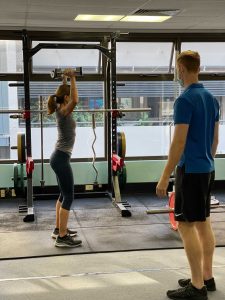Postural Kyphosis in Teenagers and Exercise
Today, Longevity Exercise Physiology Drummoyne, Edgecliff, Marrickville, Bella Vista, Randwick, Pymble, Balmain, Neutral Bay, Coburg – Melbourne, and Barrie, Ontario – Canada discuss postural kyphosis, the common causes and how exercise can help.

What is postural kyphosis?
Postural kyphosis is a curve or ‘hunch’ in the upper regions of the spine, caused by improper loading or prolonged poor posture, often in those with poor muscle strength (Feng et al, 2017). Over the long term, this can result in degeneration of the spine and other back problems, including shoulder pain and compression fractures (Seidi et al, 2014). In growing teenagers, this can even lead to problems with organ development and respiratory function (Feng et al, 2017). The normal range of thoracic curvature in teenage spines is between 20º to 40º, while a curvature of 45º or more is considered hyperkyphotic (Feng et al, 2017).
“Over the long term, this can result in degeneration of the spine and other back problems, including shoulder pain and compression fractures.”
(Seidi et al, 2014)
Why does postural kyphosis develop?
The main contributors to the development of postural kyphosis in teenagers include sitting for long periods and poor posture while sitting or standing (Feng et al, 2017). Other significant associative factors include body composition, time spent watching television, improper carrying of your backpack and its relative weight (Bueno & Rech, 2013).

How can exercise help postural kyphosis?
Most exercise interventions to correct postural kyphosis involve a combination of stretching and strengthening exercises targeting the affected area. However, recently, there has been a move towards a more holistic approach to treatment. Research has found a more functional, corrective program led to improvements in thoracic spine shape and mobility as well as the lower regions of the spine. This is particularly important, as pelvic attachment to the spine is an important predictor for long term back problems (Feng et al, 2017).
“More dynamic and active programming, encourages development of the necessary sensory connections, promoting long term postural change outside the clinic.”
(Seidi et al, 2014).
Another important component of corrective exercise interventions are proprioceptive exercises. With prolonged kyphotic posture, the ‘sense’ of correct posture can be lost, making it harder to correct long term. More dynamic and active programming, encourages development of the necessary sensory connections, promoting long term postural change outside the clinic (Seidi et al, 2014).
More holistic programs treat the actual changes in the spine that cause kyphosis, rather than just the kyphosis symptom, like a more localised program would. They also facilitate simultaneous activation of the head, neck, trunk and upper limb, improving postural realignment and delaying fatigue (Seidi et al, 2014).
What are the exercise guidelines for postural kyphosis?
Exercises that address muscle flexibility, strength and proprioception across the entire spine and its attachments appear to have the strongest impact. Guided exercise is recommended as adherence to the program is particularly important for long-term postural change (Feng et al, 2017). Also very important, is the maintenance of correct posture while exercising (Seidi et al, 2014).
“Guided exercise is recommended as adherence to the program is particularly important for long-term postural change.”
(Feng et al, 2017)

Good exercises for kyphosis include:
- Stability-based exercises for the lower back and hips
- Thoracic mobility
- Scapular retraction
- Anterior trunk stretches
- Posterior spine strengthening
If you are interested in using tailored exercise to help improve your posture, give Longevity Exercise Physiology a call on 1300 964 002 to book in a session today!
Written by Vaishnavi Pasupati
References:
Bueno, R., & Rech, R. (2013). Postural deviations of students in Southern Brazil. Revista Paulista De Pediatria, 31(2), 237-242. doi: 10.1590/s0103-05822013000200016
Feng, Q., Wang, M., Zhang, Y., & Zhou, Y. (2017). The effect of a corrective functional exercise program on postural thoracic kyphosis in teenagers: a randomized controlled trial. Clinical Rehabilitation, 32(1), 48-56. doi: 10.1177/0269215517714591
Seidi, F., Rajabi, R., Ebrahimi, I., Alizadeh, M., & Minoonejad, H. (2014). The efficiency of corrective exercise interventions on thoracic hyper-kyphosis angle. Journal Of Back And Musculoskeletal Rehabilitation, 27(1), 7-16. https://doi.org/10.3233/bmr-130411
